Leeds United on Friday announced the signing of Marc Roca from Bayern Munich. The Spanish midfielder will be Marsh’s third signing of the summer and will cost around 10 million pounds. After bringing in Brendan Aaronson and Rasmus Kristensen from Red Bull Salzburg, Roca’s joining brings Leeds’ summer spending to close to £50 million. On top of that, the Whites have also been linked to quite a number of players, including Burnley’s Nathan Collins, among many others.
Marc Roca’s rise through the ranks
Left-footed and 1.84m tall, Roca’s graceful ability on the ball, along with a straight-backed posture, is typical of Spain’s numerous outstanding number 6s. He is often compared to his compatriot, Xabi Alonso. Roca helped his country to win the U19 UEFA Euro Championships in the summer of 2019. The central midfielder was born in Barcelona and joined RCD Espanyol as a young kid in 2008, aged 11. Gradually rising through the ranks, Roca made his debut with the senior team in 2016 and scored his first goal in the top flight in 2019. In 2020, after spending almost 12 years with the Spanish club, Roca signed for Bayern Munich. Originally bought as a Thiago replacement, Roca failed to cement his place in the starting position as he featured in just 24 matches over two seasons with the German giants.
Will Marc Roca fit into Leeds United’s midfield?
From a tactical standpoint, we examine how Marc Roca’s qualities fit into Leeds United’s midfield. We start by looking at his passing and defensive abilities. After reviewing the playing styles and limitations of Leeds United’s midfielders, we compared Roca to Bayern Munich’s center midfielder using key statistical indicators.
Playing position
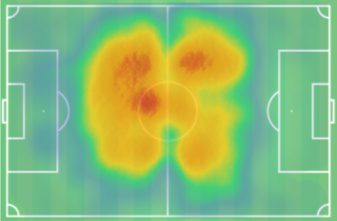
With the help of this heatmap, you can see Roca likes to operate in the middle third of the pitch. At Bayern Munich, he was usually deployed on the left side of the double pivot.
Through the latter half of this analysis, we will see how Roca, with his intelligence, movement, and skill set, helps him and his team to do the needful.
Apart from his defensive abilities, Roca is an excellent passer of the ball.
Marc Roca at Bayern Munich
In this section, we look into Roca’s role in Bayern’s midfield and how his presence affected the game. We will analyze his strengths as well as his weaknesses. This section is divided into two of his qualities. defensive and offensive.


The above pictures are perfect examples of how to study this segment. Whenever the opposing player passes the ball, Roca anticipates a pass and moves towards the opponent, giving the latter less time to settle with the ball. As he presses the opponent, he reaches for the ball first and intercepts it before the other player receives it. In these circumstances, his positional awareness is to be noted. He accepts the challenge, knowing that his teammates are well-positioned to win the second ball. Roca is a very physical player when it comes to defending. He tends to get very close to his opponents to put pressure on them. If needed, he does not shy away from tackles. When blocking passing lanes, he is highly savvy and does not shift out of defensive shape to apply pressure when there are open gaps behind him. However, if he has defensive protection and can use his cover shadow, he prefers to abandon his position and press his opponent.

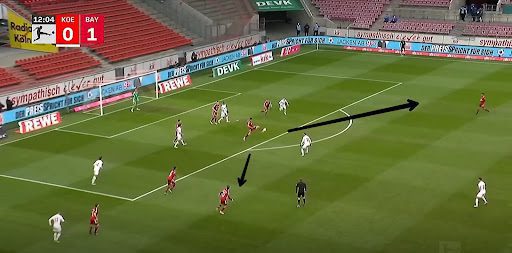
Roca’s awareness of where and how to offer cover for players is one of his most prized assets. In the example above, he has slotted into the third CB right in the middle of his own box. Roca has his eyes on the 1v1 situation on the right side of the box and notices that the opposition player is trying to move away from the right-back and pass the ball to the incoming player at the top of the penalty box. He realizes that the player is unmarked and there is a clear passing lane. Marc gradually leaves his place as the third CB and moves towards the top of the penalty box. Result? – The Spaniard intercepts the ball right on time, thus nullifying an attack, and he also has 2 clear passing options for a counterattack and eventually chooses the left-wing.

When facing counterattacks from the opposition, his defensive play is also very valuable to Bayern. They push up quite high as a result of their dominant tactics, inevitably leaving space behind. In this type of situation, Roca’s work rate is really amazing. Roca usually follows the same strategy. In this picture above, the CB is forced out of his position to press the ongoing left winger. Although there is his teammate nearer to the box, his movement and body language do not show that he is interested in slotting into the defense. Moreover, he has a player running behind him. Roca anticipates a situation and runs his way to partner Sule in the heart of the defense.
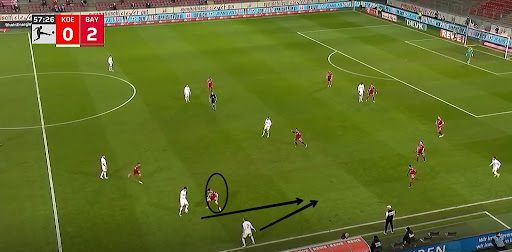

In this image, Roca is pressing the man in possession. The opponent has ample space in front of him and just needs a simple short through ball from the player. Roca is seen to be totally focused on the player with the ball. However, he does not get too close to the player because he is aware of the consequence. In the second picture, we can see Roca physically challenging the opposition fullback to win the ball. It is also evident that there are no passing options from there unless Roca slips or is just taken aback by any dazzling footwork. In a few seconds, Roca ends up winning the ball. His deft body posture aids him in this endeavor.


When it comes to being pressed, Roca is no stranger. In order to occupy a deeper position and command the tempo, a regista may require protection from his fellow midfielders. However, a modern number 6’s ability to beat the press with strong ball control is a necessary trait. Considering the above position, Marco Roco tries to get to the loose ball there. He has three players around him. A few deft touches and a smart turn, freed Roco from the dungeons of despair. At this point comes Roco’s other trait, the ability to quickly scan and make progressive passes. He spots a clear passing lane for Sane, who is wandering without his markers. A straight pass and Sane receives the ball.

One of his key patterns of play is to identify his teammates who are in the final third or open between the lines and make a fantastic pass to them. According to fbref, Roco has 88.4% of successful passes. In this example, he spots the winger sprinting towards the open space, so he lofts the ball up for a long pass. And it was inch perfect for the winger.

Roca is an excellent defender, but it is his passing ability, vision, and skills that set him apart. He’s an excellent ball distributor who can make a variety of passes. Roco is being pursued by 2 of his opponents. He has a few options nearby, but his vision helped him to find Musiala in the extreme left of the image, and he proceeds further to get some space to shoot the ball forward, breaking the defense line of the opposition.

Despite being deployed in a double pivot. Roca usually sits back as the lone DM, to shield the defense while his partner ventures up in the field. The above image proves that Roco (22) forms a triangle with the center backs while Tolisso (24) is placed a bit higher up in the pitch. From all the analysis above, it is evident why Bayern Munich follows this strategy.
Where will Roco fit into Leeds United’s midfield?
Following Marcelo Bielsa’s expulsion from the first team, Jesse Marsch has usually lined up his team in the 4-2-3-1 or 4-2-2-2 formation. His midfield always warrants a couple of central midfielders to dictate the play. However, as the Premier League table says, Leeds United have not quite fared well in terms of a solid midfield partnership. England’s Euro finalist, Kalvin Phillips, is the lone player who has cemented his position in the heart of the midfield. Marsch has tried several players, including Greenwood, Klich, Bate, etc. However, none of them have shown enough consistency to put up with their boss’ demands. To understand this section, we will analyze some of Leeds United’s gameplay in the league.
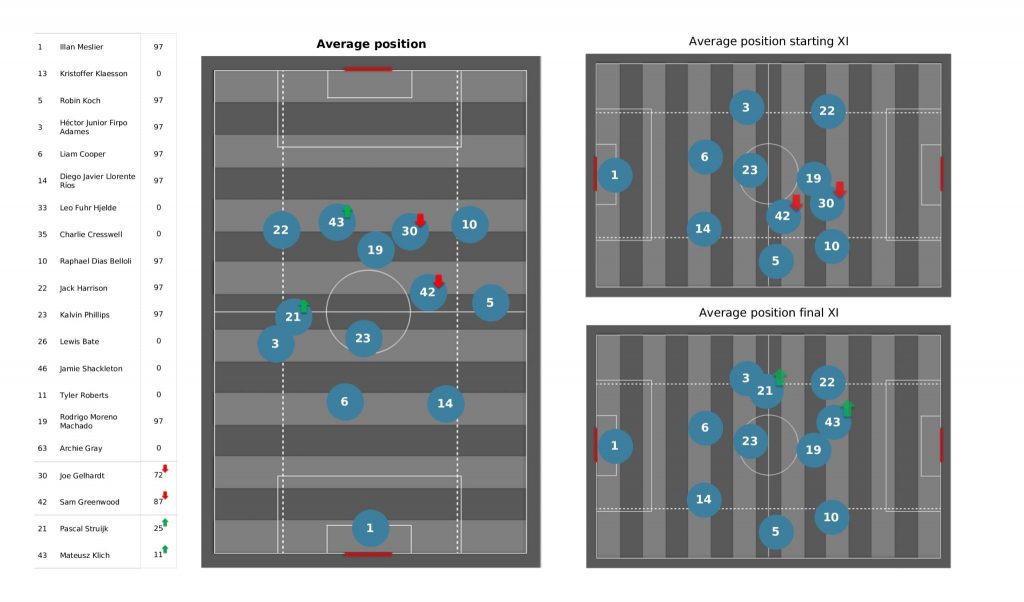
The above image shows us the average position of the central midfielders for Leeds United in a Premier League match. Phillips (23) is seen to be in his own half, operating as the lone DM at times, while his partner, Greenwood (42) is more of an offensive nature. The same setup in which Roca played in the Bundesliga.

This image shows how Kalvin Phillips, United’s supposed lone DM, moves away from the attacker. He tried to lay down an offside trap, not knowing that his teammates had already played him onside by a large margin. His inefficiency is being tactically unaware cost his team the threat from Brighton.

This angel shows the attacker with ample space in front of him and no one in his close vicinity to put pressure on him. Greenwood, due to his high position, also fails to track back in time. Kalvin Phillips, on the other hand, completely abandoned his man, leading to this. In situations like this, Marc Roca is definitely an upgrade due to his superior tactical knowledge and awareness.
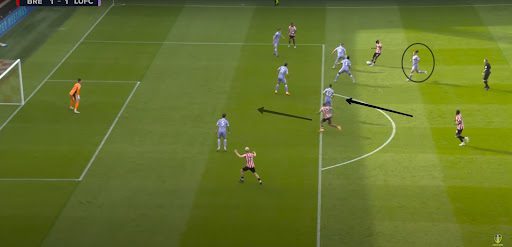
This setup also exposes Leeds United’s midfield. Kalvin Phillips can be seen in a circle near the attacker as the latter is gearing up for a pass in the penalty box. Phillips is neither pressing the attacker nor contributing in any way to the defense. Greenwood, the other CM, seems to be right at the top of the box but is completely unaware that his marked man is on his way following the ball. As seen in the previous segment, Roca has always stationed himself as the third CB in case of an attack. A Roca-esque movement could come in handy at this point.
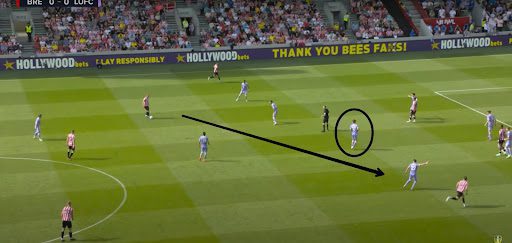
A glaring example reveals Leeds United’s midfield experiencing brain fade. A playmaker like Erikson is left unmarked, without any pressure as he gears up for a long ball for his teammate. He has the time to judge and analyze his pass. Why? Kalvin Phillips is just wandering in the middle. His partner is also just watching Erikson from a distance. Roca averages around 25 pressures per 90, something Leeds are definitely missing.

Neither of the central midfielders are closing in on the unmarked player in the box. Roca has exceptional vision to cut off the opposition’s passing lanes. He achieves that by being in close contact with the receiver and not the passer. On top of that, his decent tactical knowledge also makes his work easier. While he lacks Thiago’s low center of gravity, his lengthy legs allow him to tackle players and intercept passes that would otherwise be out of reach.
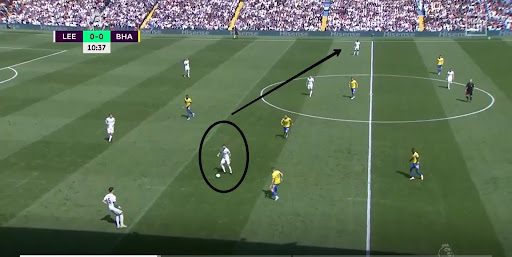
This is where a lack of vision and creativity bereaved Leeds United of a glorious attack through the wings. Greenwood has the ball, and he just simply passes the ball back to his own defenders. However, a simple look over the shoulder and he would have seen Junior Firpo waiting on the left wing with no marker at all. However, Greenwood is not so famous for his long balls, so a lack of a good passer obviously restricts Leeds United.

An exact replica of the previous scenario. This time it is Phillips who just kicks the ball sideways. Roca, a left footed midfielder gifted with good passing abilities, could have set the ball forward with an easy left footed pass. He excels at these types of passes, and his through and long balls from the left can also be used to release the attackers.
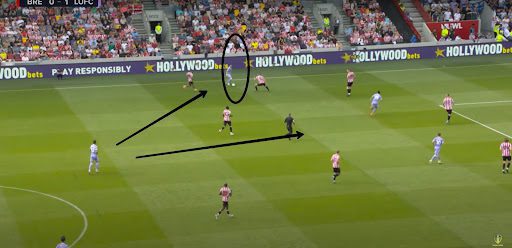
Leeds’ winger is left alone and is looking for options. Greenwood is walking forward, but he has the chance to venture forward to receive a pass and then lay a through ball for his attackers. Roca has a particular personality. Roca, a different style of a playmaker than Leeds United’s current playmakers, might provide a new dimension to their game.
Now I don’t mean to criticize Kalvin, he is a smart guy to have on the pitch and know how to block passing lanes and land critical passes from the middle of the park. But if Marsch wants to adapt to a counter-pressing game, then having someone who can do a bit of both (pressure and block lanes) at the same time is a big asset. And despite that being said, I hope that Leeds United keep hold of Phillips – atleast one more season, if not more.
Author’s opinion
It is too early to make substantial claims about his success in the Premier League. I’ve looked at the most crucial components of Roca’s ability in my tactical study. He clearly has a lot of room for improvement, but it doesn’t take away from the fact that he is already a fantastic player. Overall, Roca possesses the technical skills and passing range necessary to succeed in United’s midfield. While his defensive numbers are undeniable, the disparity in leagues causes us to tread carefully when making definitive statements. Roca boasts a number of important traits, many of which are distinct assets for a Leeds United team that is clearly struggling. He mixes defensive tenacity with offensive zeal and the ability to bring himself into potentially hazardous circumstances within the box. I compared Roca’s regista-like characteristics to Leeds United’s centre-midfielders in this scout report. Furthermore, Roca’s defence and distribution have the ability to flourish in England’s top flight, according to a simple visual study.



















